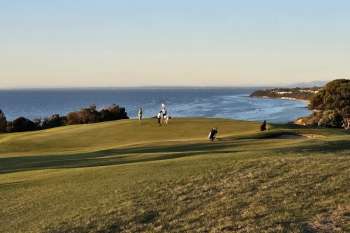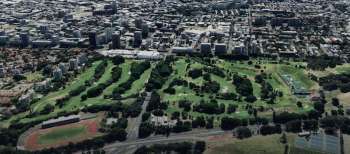The Australian Golf Digest Top 100 for 2010 is now just one month away, and as we await the final, collated results it’s worth looking at what some of Australia’s established golf clubs have been doing to improve their position on our list.
With the introduction of so many fresh faces recently, many of those older clubs that for years had survived on reputation alone have been forced to reinvigorate their tired layouts. The number of courses to have received major facelifts over the last decade has been quite surprising; as has the fact that so many of the courses once managed by Peter Thomson’s design company are now carrying the Michael Clayton stamp.
Whether it’s a reflection on the quality of their consulting work or their increased focus on new course design and international projects, the loss by Thomson Perrett of plum consulting contracts at clubs like Victoria, Royal Queensland, Peninsula, Lake Karrinyup, The Lakes and most recently Royal Adelaide is significant. Not only has it allowed Clayton’s design team to quickly establish a foothold and build an impressive portfolio of completed work, but it’s marginalised an approach to course maintenance that was, quite frankly, damaging to our industry.
For years the unchallenged approach to existing courses was to coat over perceived inadequacies of design by simply planting trees, narrowing fairways or adding bunkers – and to keep doing this until holes were no longer deemed ‘easy’. This happened regularly across Australia, and repairing such damage can be difficult as members grow attached to their trees and often struggle to appreciate how sensible redesign programs or the restoration of important lost features will improve their golfing experience.
Thankfully in recent years there has been a noticeable shift in mindset and a reawakening to the virtues of Golden Age design. People like Clayton have helped push the case for change by speaking bluntly and challenging clubs to address course deficiencies by making hard decisions. On the surface some of his redesign projects seemed radical, but this is only because his clients had so badly neglected their layouts that a painful reversal was the only road to recovery.
Mike Clayton isn’t the only architect working on major redesigns, but he is responsible for the most notable facelifts of the past few years – including the Lakes and Lake Karrinyup, both former Top 10 courses that have been steadily sliding down our list. Here is a brief overview of his most recent projects.
Grange West
Essentially routed across the same ground, the work at the Grange mostly involved greens, bunkers and the clearing of some invasive tea-tree and scrub. The land here is quite compact, and by comparison to a number of Clayton’s other projects, this is a little on the tame side with subtle shapes and only a handful of really loud greens. There isn’t anything wrong with subtle by the way, but on occasion the layout lacks visual impact, particularly on its flatter areas and through the tighter playing corridors. A hole like the 7th, for example, is far more interesting than it appears from the tee, as dull ground and shallow fairway traps disguise a very clever and strategic short par four. Score B-
Peninsula South
While the South Course at Peninsula doesn’t enjoy the same tumbling terrain as the North Course, it’s plenty undulating and boasts a strong set of holes that are sure to appeal to a large portion of our panel. Generally the layout is longer, flatter and more difficult than the North, but there are some tremendous shorter holes like the split-ditch 1st, the strategically proportioned 7th and the nasty new par three 17th. The wild hog’s-back par five 8th is also great fun as is the strong two-shot 13th. Score B+
Lake Karrinyup
Clayton’s focus at Lake Karrinyup was mostly on returning tired greens and bunkers to the rugged, naturalistic form that Alex Russell had originally wanted. He also realigned some fairways and green entrances to reduce the number of hook favoured holes. Among our panel to have seen the changes, the view seems to be that the layout has improved and it wouldn’t surprise to see the course ranked higher in 2010 than it was in 2008. Score B+
The Lakes
Unlike Lake Karrinyup, changes made to The Lakes were far more wide reaching. Again the routing was largely preserved, essentially because it made good use of the natural lakes, but the character of the course was altered substantially. The non-indigenous trees and shrubs were removed, as was the couch and ryegrass fringes and the awful grass faced bunkers and ugly pot traps that dotted the landscape. In their place Clayton’s team scatted vast sandy wastelands across the site and added sprawling roughed-up bunker shapes, giving The Lakes a distinct linksy feel, much like the courses in this part of Sydney had 50 years ago. They also built outrageously contoured putting surfaces, some with multiple ridges, split tiers and nasty pinable wings or shelves.
There is no doubt that change was needed here, and equally that this is precisely the sort of layout the property demanded. That said, it’s unlikely that all members will fully appreciate the subtleties of the new course and some will clearly feel that Clayton went too far on the more extreme green sites. While there certainly are problem spots, the heaviest putting contours here are also among the most interesting. The 14th is a prime example, the famous water carry par five now ends at an enormous target that collapses violently down an incline toward the edge of the lake. This is a brutal green if 60-feet away from the pin, but visually the shapes fit with the surrounding landscape, and those who groan about three-putt pars will need to either hit better long irons or rethink their strategy on how best to play the hole.
The drivable par four 13th is even more sinister, its narrow, raised green is reminiscent of the 5th at Woodlands and built with a tight frontal entrance that kicks sloppy pitch shots down a sharp embankment. The hole itself will improve considerably with the removal of a couple of trees that partly block the favourable right side of the fairway. The other strategic short four of note here is the 6th, which bends around a well-shaped bunker complex that golfers can either attack or avoid depending on their skill level or bravery. Again the green is a wild concoction of slopes, the softer front portion much easier on the eye and working better from a strategic perspective than the nasty left ledge. Aside from a few other severe tiers and the all-carry wasteland across the 4th fairway, about the only area that stands out as uncomfortable here is the 11th green, chiefly because the raised edges on both its left and right sides are more obviously manufactured than others on the course.
Without question the biggest concern with The Lakes, however, remains its choice of fairway grass. Kikuyu is a poor surface for such an exposed and bumpy site, especially now that fringe and putting contours seem to encourage the creative, running approach. Missing greens at The Lakes would be a lot more challenging were bump and run shots viable alternatives to the aerial chip. Having shut the course down for extended periods while the holes were rebuilt, it seems unlikely that the fairway grass will change anytime soon and that’s a shame. It’s also likely to hold the course back in our forthcoming Top 100 list, given that the criteria for conditioning has been altered from lush and green to firm and fast and Kikuyu’s only advantage over couch or fescue is its year-round colour. Score A-
Royal Queensland
In a sense, similar issues are faced at another Clayton client – Royal Queensland, which was virtually rebuilt in 2007 following the government’s decision to expand a bridge across the club’s property. The difference between Royal Queensland and The Lakes is sand and terrain, the virgin land here was clay-based and virtually devoid of any redeeming golfing features. This makes Clayton’s work at RQ even more impressive, yet like The Lakes for the members to properly enjoy these fascinating holes the fairways and green surrounds will need to be kept tight and bouncy, which is not easily done in Brisbane.
What’s special about Royal Queensland is that the course is so unique; it doesn’t look like anything else you’ve played and despite the unfavourable terrain it’s beautiful and manages to hold your interest throughout the round. Shaped virtually from scratch, the par threes are very good, especially the pushed-up 8th, while the short fours and par fives are all bunkered strategically to encourage aggressive play but appropriately punish those over-stretching themselves. Especially impressive is the ease with which lesser skilled players can get around. Play smart and there are endless ways to approach a particular hole, but always with enough temptation to incite the dangerous play from a cavalier golfer. Score A
Although the redesign at Royal Queensland (along with Grange West and Peninsula South) was completed prior to the 2008 ranking, it was brand new when we compiled our last list and many judges hadn’t seen the changes. One of the areas we are focused on improving with the 2010 ranking, however, is ensuring that our panel is more active and judging all courses in their most recent guise. Ranked in the mid 50s last time, Royal Queensland clearly deserves better.
As does an unranked hidden gem in Victoria’s Yarra Valley, the RACV Club at Healesville, which Clayton and his associate Michael Cocking have redesigned into a fabulous little layout with loads of character. Thankfully the brief here was not about stretching the course to championship length, but rather working with the existing landforms and a manmade roving ditch to build a collection of fun, playable holes for golfers of all abilities. The course is only par 68 but there is so much to like about Healesville, not the least being the simple, natural look of the green and bunker shapes, and the sheer quality of the ditch-split 420-metre 8th and short fours like the 6th, 17th and 18th.
Although it’s unlikely to make an appearance on our Top 100, the quality of the Healesville holes further enhances the reputation of Mike Clayton and his team. Their next significant project may well be Royal Adelaide, which is in dire need of some direction and sensible restoration, and which recently employed the company to prepare a masterplan for future works. It will be interesting to see whether Clayton’s plans are adopted here or discarded as too difficult. Drastic change won’t be easy to sell at Royal Adelaide, but it’s possible next months Top 100 list will help push the case.
Darius Oliver, Architecture Editor Australian Golf Digest




